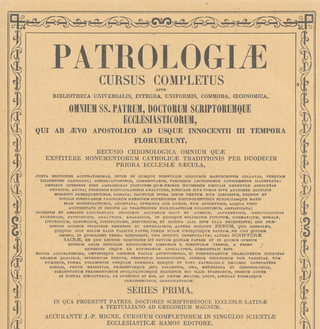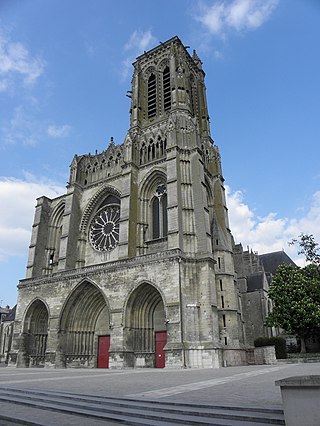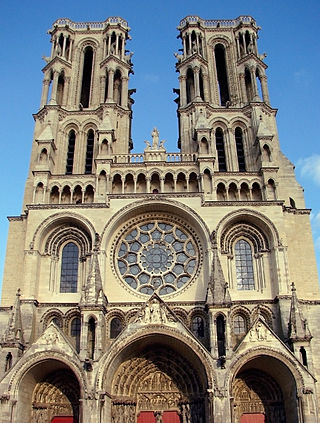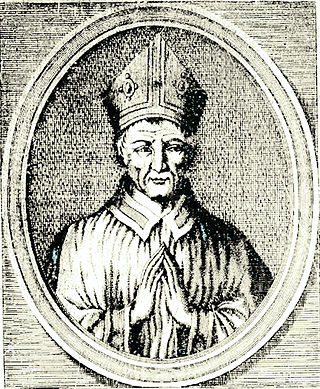Related Research Articles

Pope Gregory VII, born Hildebrand of Sovana, was head of the Catholic Church and ruler of the Papal States from 22 April 1073 to his death in 1085. He is venerated as a saint in the Catholic Church.
William de Corbeil or William of Corbeil was a medieval Archbishop of Canterbury. Very little is known of William's early life or his family, except that he was born at Corbeil, south-east of Paris, and that he had two brothers. Educated as a theologian, he taught briefly before serving the bishops of Durham and London as a clerk and subsequently becoming an Augustinian canon. William was elected to the See of Canterbury as a compromise candidate in 1123, the first canon to become an English archbishop. He succeeded Ralph d'Escures who had employed him as a chaplain.
Guibert de Nogent was a Benedictine historian, theologian, and author of autobiographical memoirs. Guibert was relatively unknown in his own time, going virtually unmentioned by his contemporaries. He has only recently caught the attention of scholars who have been more interested in his extensive autobiographical memoirs and personality which provide insight into medieval life.
Ranulf Flambard was a medieval Norman Bishop of Durham and an influential government official of King William Rufus of England. Ranulf was the son of a priest of Bayeux, Normandy, and his nickname Flambard means incendiary or torch-bearer, and may have referred to his personality. He started his career under King William I of England, probably in the compilation of the Domesday Book of 1086, as well as being the keeper of the king's seal. On the death of William I, Ranulf chose to serve the new king of England, William Rufus.

Guibert or Wibert of Ravenna was an Italian prelate, archbishop of Ravenna, who was elected pope in 1080 in opposition to Pope Gregory VII and took the name Clement III. Gregory was the leader of the movement in the church which opposed the traditional claim of European monarchs to control ecclesiastical appointments, and this was opposed by supporters of monarchical rights led by the Holy Roman Emperor. This led to the conflict known as the Investiture Controversy. Gregory was felt by many to have gone too far when he excommunicated the Holy Roman Emperor Henry IV and supported a rival claimant as emperor, and in 1080 the pro-imperial Synod of Brixen pronounced that Gregory was deposed and replaced as pope by Guibert.

The Patrologia Latina is an enormous collection of the writings of the Church Fathers and other ecclesiastical writers published by Jacques-Paul Migne between 1841 and 1855, with indices published between 1862 and 1865. It is also known as the Latin series as it formed one half of Migne's Patrologiae Cursus Completus, the other part being the Patrologia Graeca of patristic and medieval Greek works with their medieval Latin translations.

The Archdiocese of Reims or Rheims is a Latin Church ecclesiastic territory or archdiocese of the Catholic Church in France. Erected as a diocese around 250 by Sixtus of Reims, the diocese was elevated to an archdiocese around 750. The archbishop received the title "primate of Gallia Belgica" in 1089.

Walkelin was the first Norman Bishop of Winchester. He began the construction of Winchester Cathedral in 1079 and had the Old Minster demolished. He reformed the cathedral's administration, although his plan to replace the monks with priests was blocked by the Archbishop of Canterbury, Lanfranc. Walkelin was important in beginning St Giles's Fair in Winchester and was greatly active in national politics. For example, he signed the Accord of Winchester, was involved in the Council of London in 1075, and sought to resolve a conflict between Anselm of Canterbury and William II. He was regent of England for a few months at the end of his life.
Manasses I, known as Manasses de Gournay, was the Archbishop of Reims, and thus primate of France, from c. 1069 to his deposition on 27 December 1080.

The Diocese of Amiens is a Latin Church diocese of the Catholic Church in France. The diocese comprises the department of Somme, of which the city of Amiens is the capital.
Hugh of Die was a French Catholic bishop.

The Diocese of Soissons, Laon, and Saint-Quentin is a Latin Church diocese of the Catholic Church in France. The diocese is suffragan to the Archdiocese of Reims and corresponds, with the exception of two hamlets, to the entire Department of Aisne. The current bishop is Renauld Marie François Dupont de Dinechin, appointed on 30 October 2015. In the Diocese of Soissons there is one priest for every 4,648 Catholics.

The diocese of Laon in the present-day département of Aisne, was a Catholic diocese for around 1300 years, up to the French Revolution. Its seat was in Laon, France, with Laon Cathedral. From early in the 13th century, the bishop of Laon was a Pair de France, among the elite.

The Diocese of Lisieux was a Roman Catholic ecclesiastical territory in France, centered on Lisieux, in Calvados. The bishop of Lisieux was the Ordinary of the Roman Catholic Diocese of Lisieux. The bishopric was suppressed during the French Revolution and was not reinstated. Present day Lisieux is part of the Diocese of Bayeux.

Barthélemy de Jur was a French bishop. He was bishop of Laon from 1113 to 1151. Some documents give his name as Barthélemy de Grandson or de Joux.

Pierre Aycelin de Montaigut or Montaigu, Montagu, known as Cardinal de Laon, born between 1320 and 1325 and died 8 November 1388, was a fourteenth-century French cardinal, who was the bishop of Nevers (1361–1371) and bishop of the Diocese of Laon (1371-1386), advisor to the king of Charles V and peer of France.
Gerard II, sometimes Gerard of Lessines, was the thirty-third bishop of Cambrai from 1076 and the last who was also bishop of Arras. He was a prince-bishop of the Holy Roman Empire, and his episcopacy coincided with the beginning of the Investiture Controversy between emperor and pope.
The Christchurch Dragon is a legend associated with the town of Christchurch, Dorset, on the south coast of England. The legend has its origin in a mid-12th century French manuscript written by Hermann de Tournai, which tells how a party of canons from the cathedral of Notre-Dame in Laon, France, witnessed a five-headed dragon destroy the church and much of the town. Although well-documented, the legend is little-known in the town of its origin.

Ralph IV was a northern French nobleman who amassed an extensive array of lordships lying in a crescent around the Île-de-France from the border of the Duchy of Normandy in the northwest to Champagne in the southeast.
Hubert was bishop of Therouanne from 1078/9 to 1081. He was formerly the archdeacon of the same diocese. He was reprimanded several times by Pope Gregory VII, and even excommunicated, but according to other sources he was well-lettered and was positively concerned with the ecclesiastical property of his diocese, putting it in good order and increasing its revenues.
References
- 1 2 3 4 Paul J. Archambault, A Monk's Confession: The Memoirs of Guibert of Nogent (Pennsylvania State University Press, 1996), pp. 122–124.
- 1 2 3 4 John F. Benton, Self and Society in Medieval France: The Memoirs of Abbot Guibert of Nogent (University of Toronto Press, 1984), pp. 146–147.
- ↑ Tom Licence, Edward the Confessor: Last of the Royal Blood (Yale University Press, 2020), pp. 127, 129.
- 1 2 3 Suzanne Martinet (1991), "Élinand, évêque de Laon méconnu (1052–1098)", Mémoires de la Fédération des Sociétés d'histoire et d'archéologie de l'Aisne36: 58–78.
- ↑ Tom Licence (2013), "Robert of Jumièges, Archbishop in Exile (1052–5)", Anglo-Saxon England42: 311–329. doi : 10.1017/S0263675113000161
- ↑ H. E. J. Cowdrey (1992), "Pope Victor and the Empress A.", Byzantinische Zeitschrift, 84–85(1–2): 43–48. doi : 10.1515/bz-1992-1-211
- ↑ Margarita Torres Sevilla-Quiñones de León and José Miguel Ortega del Rio, Kings of the Grail: Tracing the Historic Journey of the Holy Grail from Jerusalem to Spain (Michael O'Mara Books, 2015), pp. 86–87.
- ↑ John R. Williams (1949), "Archbishop Manasses I of Rheims and Pope Gregory VII", The American Historical Review54(4): 804–824. JSTOR 1844303
- ↑ H. E. J. Cowdrey, Pope Gregory VII, 1073–1085 (Clarendon Press, 1998), p. 363, 382.
- ↑ T. A. Archer (1887), "Ranulf Flambard and His Sons", The English Historical Review2(5): 103–112. doi : 10.1093/ehr/ii.v.103-b
- ↑ John S. Ott, Bishops, Authority and Community in Northwestern Europe, c.1050–1150 (Cambridge University Press, 2015), pp. 51–52.